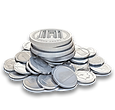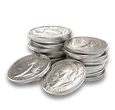🪙 What Are Semi-Numismatic Coins — and Should You Buy Them?
- GoldsilverJapan

- Sep 13
- 5 min read
What Are Semi-Numismatic Coins?
Semi-numismatic coins are hybrid coins that sit between pure bullion and traditional collector (numismatic) coins. They contain precious metal value based on their gold, silver, platinum, or palladium content — but they also carry an added premium due to their limited design, low mintage, or collectible appeal.
They are popular with certain collectors and investors because they offer the potential for appreciation beyond just the melt value of the metal.
But unlike pure bullion coins — which are valued almost entirely on their metal content — or fully numismatic coins — which are prized for their rarity, history, and condition — semi-numismatic coins exist in a gray area. They’re only as valuable as the market demand allows.
Characteristics of Semi-Numismatic Coins
Feature | Description |
Metal Content | Usually 1 oz of silver, gold, platinum, or fractional weight |
Mintage | Often limited (but not always rare) |
Design | Commemorative, themed, or artistic |
Premium | Higher than bullion, lower than rare collectibles |
Issuer | Typically from a government mint or well-known private mint |
Resale Value | Can fluctuate depending on demand |
Should You Buy Semi-Numismatic Coins?
For Beginners — Not Recommended
If you're just getting started with precious metals, semi-numismatic coins are not the best place to begin.
Here’s why:
They often carry significantly higher premiums than standard bullion coins or bars.
Many buyers don’t realize they are paying for collectibility, not just metal content.
If you decide to sell, it’s very possible you’ll get an offer close to melt value, not the premium you paid.
In short: Only buy semi-numismatics if you’re collecting — not investing.
You need to understand:
You’re paying for the art, mintage, packaging, or hype.
You should enjoy the coin regardless of its resale value.
Don’t expect to make a profit — at least not quickly.
Key Examples of Semi-Numismatic Coins
Let’s take a look at real-world examples of coins that have walked this line between bullion and collectible:
🦢 Australian Swan Series (Perth Mint)
Introduced in 2017 with massive buzz
Low mintage and high design appeal
Initial premiums were 70–100% above spot
Early buyers hoped for long-term appreciation
Today, many versions are treated like standard bullion — resale premiums have dropped sharply
Lesson: Hype can fade. What starts as “limited and collectible” can end up being sold for melt value.
🇲🇽 1 oz Silver Libertad (Mexico)
No face value, but issued by Banco de México
Highly sought after in certain years and finishes (e.g., proof, antique)
Low mintage in some years has driven premiums up
Still one of the better-performing semi-numismatic coins
Cult-like following in Latin America and among global collectors
🐉 Perth Mint Lunar Series (Australia)
Yearly zodiac-themed designs in silver and gold
Very popular in Asia
Limited production with strong collector interest
Some older years appreciate in value — others plateau
Finish types (proof, colorized, gilded) can vary in appeal
🐘 Somalian Elephant Series
Annual wildlife-themed releases
Issued by the Bavarian State Mint
Beautiful designs, but inconsistent resale value
Early releases carry some premium — newer ones often do not
🐯 South Korean Chiwoo Cheonwang Series
Unique themes rooted in Korean mythology
Some versions are treated as collectible
Early releases saw strong aftermarket demand
Later releases oversaturated — premiums have compressed
Bullion vs Semi-Numismatic vs Numismatic: A Quick Breakdown
Type | What You’re Paying For | Typical Premium | Resale Potential |
Bullion Coin | Pure metal weight | 5–10% | Close to spot |
Semi-Numismatic | Design + metal + demand | 15–40% or more | Variable |
Numismatic Coin | Rarity + historical value | 100%+ | Collector-driven |
The Problem with Premiums
One of the biggest pitfalls with semi-numismatic coins is that buyers don’t always realize they’re paying far above spot.
Example:
Let’s say:
Spot silver is $42/oz
You buy a semi-numismatic 1 oz silver coin for $80
Premium paid: $38 (90%)
What happens when you sell?
If demand is still high, you might get $100 — great.
But if demand has faded, you may get just melt value: $42–$45
Net loss: You could lose more than 40% of your money despite silver prices staying flat or even rising.
When Semi-Numismatics Work
They’re not all bad. Some semi-numismatic coins have outperformed standard bullion over time — but this is usually the exception, not the rule.
These coins tend to succeed when:
🧾 The design is part of a long-term, successful series
📉 The mintage is extremely low and the coin is not overpromoted
🌍 There’s international collector demand
💼 The coin is sold in original mint packaging and condition
🕰️ You’re willing to hold long-term (5+ years)
When They Fail
Semi-numismatic coins often underperform when:
They’re released with excessive hype
The mintage is not as limited as advertised
The theme is too gimmicky or "trend-based" (e.g., pop culture, fantasy)
They’re colorized, gilded, or altered in a way that turns off traditional buyers
Buyers expected numismatic-like returns — and got bullion-like resale offers
How to Evaluate a Semi-Numismatic Coin Before Buying
🔍 Use this checklist:
✅ Is it from a respected mint (Perth Mint, RCM, Banco de Mexico, etc.)?✅ Is the mintage low and clearly documented?✅ Is there a history of collector demand for similar issues?✅ Can you verify resale data on platforms like APMEX, eBay, or collector forums?✅ Would you still be happy owning the coin if it never appreciated in value?
If your answers lean toward "yes" — and you’re buying with eyes open — go for it.
Where to Buy (and What to Watch For)
Source | Pros | Cons |
Reputable Dealers (APMEX, SD Bullion, GoldSilverJapan) | Certified, consistent inventory | Prices can be high at launch |
Official Mints | Authenticity guaranteed | Limited editions sell out fast |
eBay / Secondary Market | Access to older coins, bargains | Higher risk of overpaying or fakes |
Coin Shows & Conventions | Physical inspection possible | Requires experience to negotiate |
Tip: Be cautious about impulse buys. Some coins are marketed as “rare” or “first strike” — but in reality, thousands exist and may not hold value.
Gifting, Collecting, or Holding?
Semi-numismatic coins do shine in three key areas:
🎁 Gifting
Their designs and packaging make them perfect for holidays, birthdays, and special occasions. Think of them as precious metal greeting cards.
🖼️ Personal Collection
If you enjoy owning beautiful or themed coins, semi-numismatics offer variety without the intimidating price tags of historical numismatics.
🗓️ Holding for the Long Term
If you’re patient, certain coins — like early Libertads or limited Lunar series — may appreciate nicely over 5–10 years.
But none of these guarantee profit.
Final Thoughts — Should You Buy Them?
Yes, if:
You’re collecting for passion, not profit
You understand what you’re paying for
You’ve already built a solid bullion base
You’re selective with what you buy
You’re willing to hold long-term
No, if:
You’re stacking purely for weight and liquidity
You’re new to precious metals and just starting
You’re uncomfortable with price volatility
You expect quick resale or high premiums
You don't understand collector behavior or mint dynamics
Beginner’s Rule of Thumb
Start your stack with standard bullion:
American Eagles
Silver Maple Leafs
1 oz Rounds or Bars
Junk silver
Then — once you’ve learned the basics and understand the market — experiment with 1 or 2 semi-numismatic coins that speak to your personal taste or goals.
Summary
Semi-numismatic coins can be:
🎨 Visually stunning
🎁 Great for gifts
💰 Potentially profitable — but only sometimes
🧠 Confusing to value if you’re not careful
🪙 Often resold at bullion pricing
They are not a “get rich” shortcut — they are a niche within a niche. But if approached with the right mindset, they can be a rewarding part of your collection.











Comments